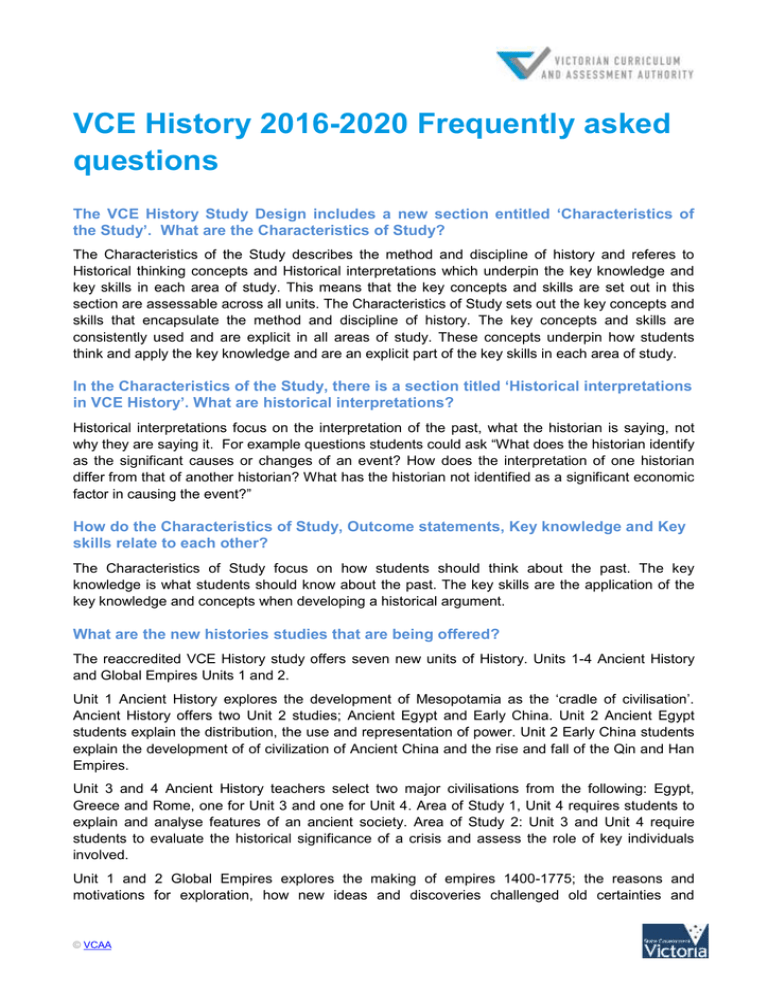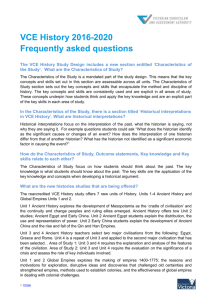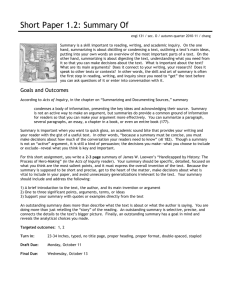VCE History 2016-2020 Frequently asked questions
advertisement

VCE History 2016-2020 Frequently asked questions The VCE History Study Design includes a new section entitled ‘Characteristics of the Study’. What are the Characteristics of Study? The Characteristics of the Study describes the method and discipline of history and referes to Historical thinking concepts and Historical interpretations which underpin the key knowledge and key skills in each area of study. This means that the key concepts and skills are set out in this section are assessable across all units. The Characteristics of Study sets out the key concepts and skills that encapsulate the method and discipline of history. The key concepts and skills are consistently used and are explicit in all areas of study. These concepts underpin how students think and apply the key knowledge and are an explicit part of the key skills in each area of study. In the Characteristics of the Study, there is a section titled ‘Historical interpretations in VCE History’. What are historical interpretations? Historical interpretations focus on the interpretation of the past, what the historian is saying, not why they are saying it. For example questions students could ask “What does the historian identify as the significant causes or changes of an event? How does the interpretation of one historian differ from that of another historian? What has the historian not identified as a significant economic factor in causing the event?” How do the Characteristics of Study, Outcome statements, Key knowledge and Key skills relate to each other? The Characteristics of Study focus on how students should think about the past. The key knowledge is what students should know about the past. The key skills are the application of the key knowledge and concepts when developing a historical argument. What are the new histories studies that are being offered? The reaccredited VCE History study offers seven new units of History. Units 1-4 Ancient History and Global Empires Units 1 and 2. Unit 1 Ancient History explores the development of Mesopotamia as the ‘cradle of civilisation’. Ancient History offers two Unit 2 studies; Ancient Egypt and Early China. Unit 2 Ancient Egypt students explain the distribution, the use and representation of power. Unit 2 Early China students explain the development of of civilization of Ancient China and the rise and fall of the Qin and Han Empires. Unit 3 and 4 Ancient History teachers select two major civilisations from the following: Egypt, Greece and Rome, one for Unit 3 and one for Unit 4. Area of Study 1, Unit 4 requires students to explain and analyse features of an ancient society. Area of Study 2: Unit 3 and Unit 4 require students to evaluate the historical significance of a crisis and assess the role of key individuals involved. Unit 1 and 2 Global Empires explores the making of empires 1400-1775; the reasons and motivations for exploration, how new ideas and discoveries challenged old certainties and © VCAA VCE History 2016-2020 Frequently asked questions strengthened empires, methods used to establish colonies, and the effectiveness of global empires in dealing with colonial challenges. What studies have been revised? Unit 1 and 2 Twentieth Century, Unit 3 and 4 Australian History and Unit 3 and 4 Revolutions have been revised to give emphasis to the historical thinking concepts outlined in the Characteristics of the study and to provide greater specification on the key knowledge that must be taught and assessed. The Study Design sets out timeframes for each Area of Study. How do I know what to teach? The timeframes set out the chronology for each Area of Study. In Unit 3 and 4, the key knowledge points use the word ‘including’ at the end of the stem sentence, the subsequent list of knowledge are mandated content knowledge that must be taught and assessed. When teaching the course there will be additional knowledge that contextualises and elaborates the Area of study and students can use this additional knowledge in their assessments when developing an argument. In Units 1 and 2, the key knowledge points use the words ‘such as’ or ‘for example’ at the end of the stem, the subsequent list of knowledge are only suggestions or examples of knowledge that could be taught and assessed. This provides flexibility of choice in Units 1 and 2. In some areas of Units 1 and 2 the key knowledge points use the word ‘including’ at the end of the stem sentence, the subsequent list of knowledge are mandated content knowledge that must be taught and assessed. What informs the development of assessment tasks? The key knowledge, key skills and Characteristics of the study on page 10 of the VCE History study design should underpin the development of assessment tasks. Teachers are encouraged to examine the explanation of Historical thinking on pages 1-6 of the Advice for Teachers. Teachers should explicitly teach the concepts and skills that characterise historical thinking. These include: ask historical questions, establish historical significance, use sources as evidence, identify continuity and change, analyse cause and consequence, explore historical perspectives, examine ethical dimensions of history and construct historical arguments. These skills help shape the teaching program and assessment and should inform students’ historical inquiry. A single assessment task should provide the opportunity for students to demonstrate understanding and application of the charactertistics of the study and key skills. What are the four assessment tasks in the VCE History study design? What do these entail? There are four assessment tasks: a historical inquiry, an analysis of primary sources, an evaluation of historical interpretations and an essay. A historical inquiry focuses on the process of historical investigation. Students ask questions about the past; identify, select, gather and organise historical sources; analyse primary sources and historical interpretations to use as evidence when constructing an argument. The process of analysis of primary sources requires the identification, attribution, contextualisation, close analysis to identify inference and corroboration with, other sources. Primary sources must be analysed and evaluated for accuracy and reliability before being used as evidence when developing a historical argument. © VCAA Page 2 VCE History 2016-2020 Frequently asked questions The analysis of historical interpretations focuses on the interpretations of what historians say are the significant causes, changes, consequences and continuities of the past. The ability to identify and analyse different interpretations is important. An essay is the construction and communication of an argument about significance and/or causation and/or change that uses primary sources and historical interpretations as evidence. How do I design a historical inquiry assessment task? How a teacher designs a historical inquiry assessment task is a school based decision. However, there are a number of elements teachers should consider. How do I ensure authentication of students work? What key knowledge do I want to assess? How are the key skills incorporated and assessed in the task? Under what conditions will the inquiry be conducted? e.g. time allocation, assessment method, test conditions and so on. Do all students have equal access to resources? Teachers may choose to let students select from the key knowledge to investigate or the teacher may allocate a particular key knowledge common to all students to investigate, for example, the Februrary revolution. A historical inquiry incorporates the key skills of the study design and focuses on the process of historical investigation. The Advice for Teachers pages 1-6 provides guidance on the teaching of historical thinking concepts and skills. The following is a suggested process: 1. Planning Students ask questions about the past using the outcome statement and key knowledge. Students should be encouraged to use the historical thinking concepts of historical significance, continuity and change, cause and consequence in developing a historical inquiry question. For example: What were the significant causes of the Kronstadt revolt? What were the consequences of the Kronstadt revolt? What significant change did the Kronstadt revolt bring to Russian society? This is followed by initial research, identifying, selecting and organising historical sources of evidence that examine historical perspectives and interpretations that support investigation of their inquiry questions. Students should be encouraged to use concept maps and/or graphical organisers to sequence chronology and knowledge, represent data and synthesise evidence. 2. Investigating Students analyse primary sources and historical interpretations to gather evidence to support the construction of an argument. Students should be encouraged to corroborate historical sources and evaluate their accuracy and reliability. 3. Writing up Construction of a historical argument could be in the form of an essay, an extended piece of writing or a sources task. Student construction of an argument about the past should use primary sources and historical interpretations as evidence. How much time should I allocate to a historical inquiry assessment task? Time allocation of a historical inquiry can vary according to the depth and size of the inquiry task a teacher wishes to undertake with students. Time should be allocated to planning, investigating and writing up stages of the inquiry. © VCAA Page 3 VCE History 2016-2020 Frequently asked questions How do I assess a historical inquiry assessment task? When assessing a historical inquiry it is recommended that the teacher use the performance descriptors rubric in the Advice for Teachers to support their assessment. It is important to ensure the authentication of student work, particularly in a historical inquiry. It is recommended that student work is regularly collected at the end of each lesson in the planning and investigating stages to ensure authentication. Are Units 1 and 2: Ancient History pre-requisites for Units 3 and 4: Ancient History? There are no pre-requisites for any Units 3 and 4 History. Students could do Units 1 and 2: Ancient History and then complete Units 3 and 4: Revolutions. Students could do Unit 3 and 4 History without doing a Unit 1 and 2 History. How many history units can a student undertake? There are no restrictions on how many histories a student may undertake, however when a student undertakes a Unit 3 and 4 they must complete the full sequence. © VCAA Page 4





